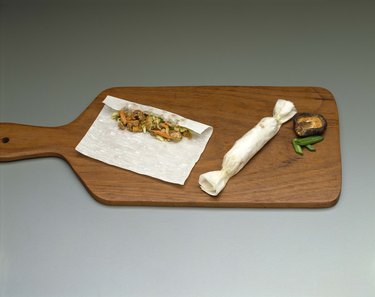Things You’ll Need
-
Cutting board or other flat work surface
-
Dry spring roll wrappers
-
Shallow sheet tray, large enough to fit flat wrappers
-
Cold water
 Spring roll wrappers must be rehydrated until they are pliable and stretchy. Image Credit: Comstock Images/Stockbyte/Getty Images
Spring roll wrappers must be rehydrated until they are pliable and stretchy. Image Credit: Comstock Images/Stockbyte/Getty Images
Spring rolls, a Chinese appetizer served in early spring at the start of a new year, are usually fried, steamed or rolled and chilled. The most time-intensive element is the outer casing, or wrapper. Spring roll wrappers are circular or rectangular and are typically made of a mixture of rice and tapioca flours. They are sold dry in large, flat stacks. You must rehydrate each wrapper individually for a brief period of time to avoid oversaturation and stickiness.
Video of the Day
Step 1
 The cutting board will serve as your final, flat rolling surface. Image Credit: Hemera Technologies/PhotoObjects.net/Getty Images
The cutting board will serve as your final, flat rolling surface. Image Credit: Hemera Technologies/PhotoObjects.net/Getty Images
Fill a sheet tray with cold water. Use enough water to submerge a single spring roll wrapper, allowing water to circulate on both sides of the wrapper. Moisten just one wrap at a time.
Step 2
Add a spring roll wrapper to the water, flipping it once or twice to ensure that both sides are moistened. Leave the wrapper submerged for between 30 seconds and two minutes, depending on the brand and type of wrapper you've purchased. The wrapper should be flexible but not overly soggy. It should be pliable but not too firm or liable to split.
Step 3
 Roll one spring roll at a time, and wipe away excess moisture. Image Credit: Jupiterimages/Stockbyte/Getty Images
Roll one spring roll at a time, and wipe away excess moisture. Image Credit: Jupiterimages/Stockbyte/Getty Images
Gently remove the wrapper, keeping it from sticking to itself, and allow excess water to drain off into the sheet tray. Carefully lay the wrapper flat on the dry cutting board, and add another dry spring roll wrapper to the water. You are now ready to begin filling, and rolling, your spring rolls. By the time you've completed one spring roll, the wrapper you placed in the water should be ready for rolling.
Tip
Fill multiple sheet trays with water for multiple soaks, but keep rolling speed in mind. You don't want the wrapper to over soak; all natural rice starches will leech out into the water, and you'll be left with soggy segments.










































